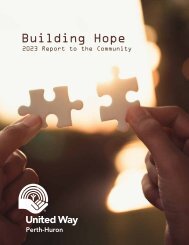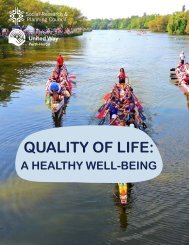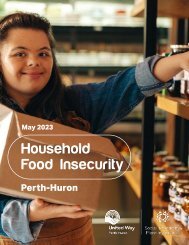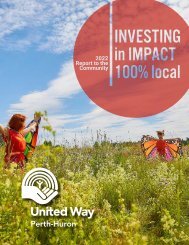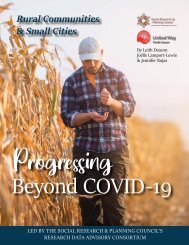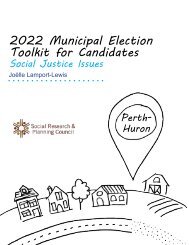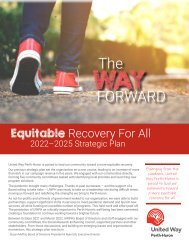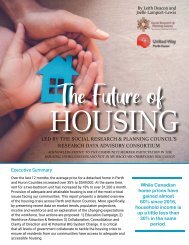2021 Supportive Housing Report
This report is designed to help enhance an understanding of homelessness and the role supportive housing can play within a larger strategy to end chronic homelessness. It provides an overview of best practices being implemented to address chronic homelessness; references supportive housing strategies that help people with the most complex mental health and addiction needs to stabilize their housing; and offers strategic actions for consideration to support the Huron and Perth communities toward achieving their goals of eradicating chronic homelessness and supporting their most vulnerable citizens.
This report is designed to help enhance an understanding of homelessness and the role supportive housing can play within a larger strategy to end chronic homelessness. It provides an overview of best practices being implemented to address chronic homelessness; references supportive housing strategies that help people with the most complex mental health and addiction needs to stabilize their housing; and offers strategic actions for consideration to support the Huron and Perth communities toward achieving their goals of eradicating chronic homelessness and supporting their most vulnerable citizens.
Create successful ePaper yourself
Turn your PDF publications into a flip-book with our unique Google optimized e-Paper software.
For people with severe needs, supportive housing is a<br />
key element in enabling them to find stable housing,<br />
lead fulfilling lives and live as independently as possible<br />
in their community. The categories of services can be<br />
customized across a variety of supportive housing<br />
models and tailored to meet people’s needs. <strong>Housing</strong><br />
stability increases for people with severe and chronic<br />
mental health and addictions challenges when multidisciplinary<br />
teams are in place and supports are<br />
available 24/7 allowing support teams to respond<br />
nimbly with tailored services suited to the individuals<br />
needs.<br />
Four examples of housing models with varying<br />
levels of support are outlined below:<br />
Permanent <strong>Supportive</strong>/Supported <strong>Housing</strong> (PSH)<br />
combines rental or housing assistance with<br />
individualized, flexible, and voluntary support services<br />
for people with moderate to severe needs related to<br />
physical or mental health, developmental disabilities, or<br />
substance use.<br />
PSH is one option to house chronically homeless<br />
individuals with high acuity. (High housing acuity<br />
meaning a person needs significant supports, often<br />
24/7, to maintain their housing and cope with daily life).<br />
Usually, PSH units are located in one home or building<br />
(congregate living) but can also be rooms in an<br />
individual house or as several and/or all units of a<br />
building. PSH units can also be offered within scatteredsite<br />
housing units 38 depending upon the acuity level of<br />
the individual and the availability of the supports<br />
(provided either through home visits or in a communitybased<br />
setting). 39<br />
Scattered Site <strong>Housing</strong> is a housing model that utilizes<br />
individual rental units located throughout the<br />
community, typically owned by private market<br />
landlords. Rent supplements are typically applied.<br />
Place-based <strong>Supportive</strong> <strong>Housing</strong> (P-BSH) is a form of<br />
congregate supportive housing with supports<br />
embedded within the housing and refers to a situation<br />
where an entire building is occupied by tenants in need<br />
of supportive housing (as opposed to just a small<br />
percentage of a building’s units being occupied by a<br />
specific population group). Place-based supportive<br />
housing can make it more efficient to offer core services<br />
to a larger group of people (e.g., 24/7 on-site supports<br />
and medication management). Additionally, P-BSH<br />
models can offer important assistance with guest<br />
management and make it relatively easy to have meal<br />
programs, as well as group social activities, such<br />
as exercise and art classes. 40<br />
On-site staff hours can vary depending on the service<br />
target group. For example, some high-support housing<br />
models for clients with moderate to severe challenges,<br />
that prevent them from living on their own, provide 24-<br />
hour staffing and crisis management, intervention, and<br />
prevention. Some programs also offer meal service and<br />
support with daily living activities.<br />
PSH and P-BSH programs are supported by a<br />
multidisciplinary team, including a mix of clinical and<br />
non-clinical community supports. Examples of multidisciplinary<br />
teams include Assertive Community<br />
Treatment (ACT) Teams 41 and Intensive Case<br />
Management (ICT) Teams 42 . Some programs supporting<br />
individuals with more complex health challenges,<br />
provide on-site clinical/nursing staff.<br />
Other models provide low to medium supports that<br />
include visits from support staff and help with tenancy<br />
issues for example. It is important that supports are<br />
flexible to enable staff to respond nimbly as people’s<br />
needs ebb and flow.<br />
Transitional/Interim <strong>Housing</strong> is intended to offer a<br />
supportive living environment for its residents, including<br />
offering them the experience, tools, knowledge, and<br />
opportunities for social and skill development to<br />
become more independent. It is considered an<br />
intermediate step between emergency shelter and<br />
permanent supportive housing and has limits on how<br />
long an individual or family can stay. In Ontario,<br />
regulation allows for 4-year transitional housing<br />
tenancies. 43 Indigenous communities do not enforce a<br />
time limit for stays in transitional housing. It is at the<br />
discretion of the community to establish parameters<br />
around time limits on transitional housing. 44<br />
Rapid-Rehousing is described by the Canadian<br />
Government as targeted and time-limited financial<br />
assistance, system navigation, and support services to<br />
individuals and families experiencing homelessness to<br />
facilitate their quick exit from shelter. 45<br />
6 <strong>Supportive</strong> <strong>Housing</strong>



